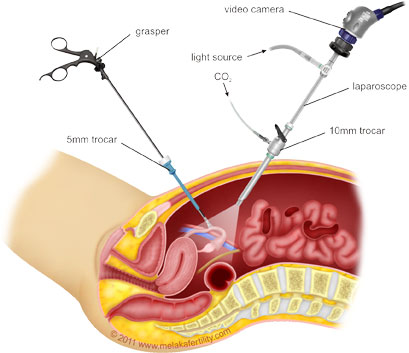
Laparoscopy is the newest surgical technique with a minimally invasive procedure. Advances in medical technology have made laparoscopy applicable in various medical sciences such as obstetrics & gynecology, digestive surgery, neurosurgery, tumor surgery, pediatric surgery, eye & ENT. Previously, doctors performed operations with conventional laparotomy / surgery, namely by making a wide incision in the abdominal wall so that the doctor's hand could enter the abdominal cavity to carry out operative procedures in it.
Laparoscopy is performed with sophisticated tools that are inserted into the abdominal cavity through a minimal incision (0.5 cm). This procedure is very suitable for cases of uterine tumors, where the patient still maintains the uterus & ovaries for further fertility function.
Advantages of the Laparoscopic Technique
- A minimally invasive procedure
- Minimal incision in the abdominal wall (only 0.5 cm)
- Fast recovery time
- Short treatment period
- The risk of postoperative adhesions is minimal
- Can return to normal activities more quickly
- It is suitable for patients who still want to maintain a healthy uterus & ovaries
Obstetrics & gynecology cases that can be handled by Laparoscopy technique:
- Myoma (benign tumor of the uterus)
- Cyst
- Pregnant outside the womb
- endometriosis
- Infertility (difficulty having children)
- Want sterile birth control
- Abdominal adhesions
- PCO (Polycystic Ovary)
- Removal of the Uterus (Hysterectomy)
How is the Laparoscopy procedure performed?
Laparoscopy is performed with a small camera (1 cm in diameter) which is inserted through the center / umbilicus & tools in the form of a "stick" (0.5 cm in diameter) which is inserted through the lower abdominal wall.
How long is the stay in the hospital after the Laparoscopic procedure?
Only one day and after that can return to normal activities.
What are the risks of the Laparoscopic technique?
Very minimal & smaller compared to conventional surgery.
What is meant by Hysteroscopy?
Hysteroscopy is part of an endoscopic procedure in gynecology where an endoscope is inserted into the uterus through the vagina to see & treat diseases originating from the inner wall of the uterus.

What cases can hysteroscopy treat?
- Submucosum myoma (myoma originating from the inner wall of the uterus)
- Endometrial polyp
- Septic uterus (a partition on the inner wall of the uterus)
- Bleeding from the genitals (clinical)
Currently Laparoscopy can also be used to remove the problematic uterus. So far, the procedure for removing the uterus is done via laparotomy (the usual operation is a wide incision of approximately 12 cm in the skin) so that the wound heals longer and the patient has to rest for about 1 month. Currently, the procedure for removing the uterus can be done by Laparoscopy, so that the skin incision is only 0.5 to 1 cm and heals much faster, only about 3 days. This certainly provides benefits and comfort for patients.
Article written by dr. Caroline Tirtajasa, SpOG (K) (Obstetric Obstetrician, Fertility & Reproductive Hormones, Laparoscopic Surgeon at EMC Pulomas Hospital).
